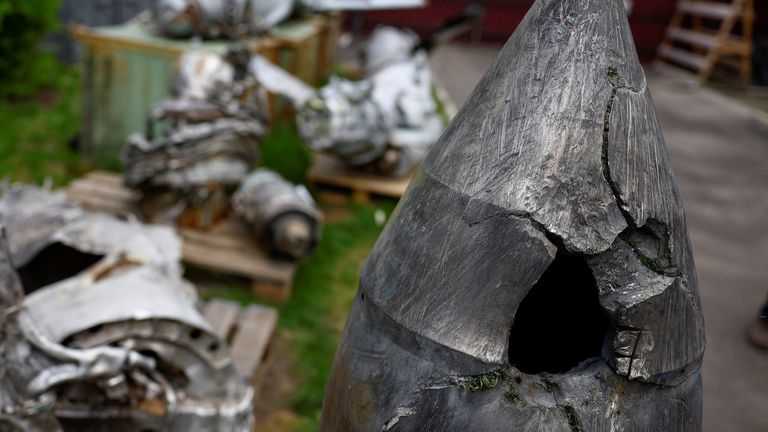Russian forces launched a huge barrage of 18 missiles at Kyiv on Tuesday. All of them were shot down, Ukraine says.
Using “onion rings” of different guns and missiles provided by the West, Ukraine’s air defences are now increasingly successful at thwarting Russian launches.
From Stinger missiles that can be carried by a single soldier to the cutting edge Patriot systems, Ukraine now has a variety of options to defend its skies.
Sky News spoke to military analyst Philip Ingram about why Kyiv’s air defences are now so effective, and the psychological boost this gives the population.
But first let’s rewind back to 24 February 2022 and the early hours the full-scale invasion when Russia launched more than 100 missiles from land and sea.
The missiles were fired at several cities including Kyiv and targeted air defence facilities and other military infrastructure. Sirens blared through the capital and the sounds of explosions could be heard downtown, catching many by surprise.
Fourteen months later, Ukraine is much better prepared.
Overnight on Tuesday, Kremlin forces launched six Kinzhal hypersonic missiles, nine Kalibr cruise missiles and three ground-launched missiles as well as drones at Ukraine. All were shot down, the country’s air force said.
Ukraine is now shooting down around 96-98% of Russian missiles thanks to a number of defence elements working together, Mr Ingram tells Sky News.
‘Onion rings’ defence
“A layered air defence system is like a series of onion rings of air defence capability,” he said.
At the lowest level, Mr Ingram says, Ukraine has guns and some of the short-range missiles like the Starstreak man-portable system provided by the UK.
“There’ll be lots of those with troops in posts around the cities or areas of critical national infrastructure.”
Ukraine then has a number of medium-range systems such as the Soviet S-300 and others supplied by its allies.
These provide a medium level anti-aircraft capability and also work against cruise missiles and drones.
And then at the top level they have the Patriot system supplied by the US and Germany.
Mr Ingram added: “And you look at this as a series of protective domes going up to different heights and out to different ranges around the target you’re trying to protect.”
While the defences have certainly been effective in shooting down missiles, it doesn’t mean there is no impact on the ground, he says. Debris from intercepted missiles falls out of the sky and can injure people below.
How does Ukraine go from detecting a missile to shooting it down?
“So the sequence of events is that Western intelligence will pick up a missile launch – there’s a mechanism to be able to transmit that in real time directly into the Ukrainians.
“That real-time launch data will identify where the missiles have been launched from, what the likely missile is and the likely trajectory that it’s on.”
The amount of time the Ukrainians have to react – from just minutes to more than an hour – depending on the type of missile.
Those in charge of air defence can then decide on the best course of action and engage the missile before it hits its target.
It’s this multiple layers of defence under a single command and control system informed by intelligence that is coming in all the time that makes it so effective, he says.
What does this mean for Ukraine’s war effort?
“It’s yet another success from the Ukrainians in what is a very, very complex and difficult battle for them as they try to save their homeland,” Mr Ingram says.
Psychologically it’s also very important, he adds, because it’s protecting the population while soldiers are at the front line.
“It’s probably one of the factors that has stopped the Russians using their fixed wing aircraft over Ukrainian territory,” he added.
“The Russians have largely restricted themselves to flying no further forward than their own frontlines.
“Now if the Ukrainians can move air defence capability further forward to their frontlines and put that bubble over their frontline troops that will then push Russian fixed-wing air and rotary-wing air back even further and help the Ukrainians in any counterattack that they’re putting together.”





